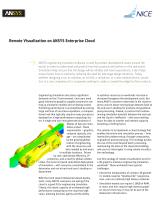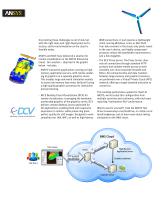
Catalog excerpts

Remote Visualization on ANSYS Enterprise Cloud ANSYS engineering simulation software is used by product development teams around the world, in order to understand and predict how their products will perform in the real world. Simulation helps ensure that the design will be reliable and meet expectations; it also helps ensure faster time to market by reducing the need for late-stage design iterations. Today, whether designing a car, an airplane, an oil drill, a cell phone, or a new medical device, simulation is a core competence for companies seeking to create a competitive edge for their products. Engineering simulation also places significant demands on the IT environment. End-users need good interactive graphics-capable systems for setting up simulation models and reviewing results. Predicting performance is accomplished by solving large matrices of non-linear equations, a computational load that typically requires many processors deployed on a high-performance computing cluster. A single end-user may generate hundreds of GBytes of data per simulation project. These requirements – graphics, compute capacity, storage – are complicated by the growing globalization of engineering, with the resources and data needed by end-users in multiple locations. Driven by cost, operational efficiency, IP protection, and a need for global collaboration, the trend is toward centralized deployment of simulation – with resources consolidated in the datacenter and not at each end-user’s desktop or department. With the trend toward datacenter-based deployment, many ANSYS customers are asking if the cloud is a good fit for engineering simulation. Clearly, the elastic capacity of on-demand highperformance computing on the cloud has high value, allowing business agility and the ability to optimize resources as workloads increase or decrease throughout the development cycle. But many ANSYS customers interested in the cloud express concern about moving large datasets back to the end-user’s desktop for analysis and graphical post-processing. Indeed, a process that involves moving simulation datasets between the end-user and the cloud is inefficient – with users waiting hours for data to transfer and network capacity becoming a limiting factor. The solution is to implement a cloud strategy that enables the end-to-end simulation process – from interactive problem setup, through computation, to graphical post-processing. This strategy pushes the use of the cloud beyond batch processing, maintaining the data on the cloud and enabling end-users to interrogate it using remote visualization technology. Can this strategy of remote visualization work for a 3D graphics-intensive engineering simulation workload? These workloads have special challenges: • Interactive manipulation of complex 3D geometric models requires “desktop-like” responsiveness, even on relatively high latency networks. • Simulation models can require 128GB of RAM, or more, and thus require high-memory graphics servers that may or may not be part of the datacen
Open the catalog to page 1
Overcoming these challenges is not trivial, but with the right tools and right deployment architecture, end-to-end simulation on the cloud is feasible today. ANSYS and NICE have delivered a solution for remote visualization on the ANSYS Enterprise Cloud. Our solution – depicted in the graphic below - includes: - ANSYS interactive applications running on highmemory application servers, with remote rendering of graphics on a separate graphics server. This enables large real-world simulation models to access the memory they need, while still using a high quality graphics processor for...
Open the catalog to page 2All ANSYS catalogs and technical brochures
-
Explicit Dynamics
8 Pages
-
Ansys SpaceClaim Direct
2 Pages
-
Ansys SCADE Display
5 Pages
-
Ansys SCADE Test
4 Pages
-
ANSYS Twin Builder
1 Pages
-
ANSYS VRXPERIENCE
4 Pages
-
ANSYS® Simplorer® 17
5 Pages
-
ANSYS FENSAP-ICE TURBO
8 Pages
-
ANSYS FENSAP-ICE
4 Pages
-
ANSYS Forte
4 Pages
-
ANSYS Model Fuel Library
2 Pages
-
Chemkin-Pro
6 Pages
-
Polyflow
8 Pages
-
ANSYS® SCADE LifeCycle® 17.0
2 Pages
-
ANSYS® SCADE Suite® 17.0
7 Pages
-
ANSYS Maxwell
2 Pages
-
ANSYS DesignXplorer
8 Pages
-
Meshing Solutions
4 Pages
-
ANSYS Q3D Extractor
2 Pages
-
ansys-icepak-brochure
8 Pages
Archived catalogs
-
ANSYS HFSS
2 Pages
-
ANSYS AIM
2 Pages
-
Discovery
2 Pages
-
ANSYS SpaceClaim
2 Pages
-
ANSYS AIM
2 Pages
-
turbomachinery
4 Pages
-
ANSYS® SCADE Display® 17.0
6 Pages
-
ANSYS® SCADE System® 17.0
6 Pages
-
ANSYS SIwave
2 Pages
-
ANSYS SpaceClaim
2 Pages
-
Hybrid Electric Powertrain
2 Pages
-
High-Performance Computing
8 Pages
-
ANSYS® SCADE Test™ 17.0
4 Pages
-
ANSYS Structural
2 Pages
-
SCADE System ® R16
5 Pages
-
EMIT
5 Pages
-
ANSYS 17.0 Capabilities
19 Pages
-
Fluid Dynamics
8 Pages
-
Electromagnetics
12 Pages
-
ANSYS Meshing Solutions
4 Pages
-
Ansys brochure
12 Pages
-
SIwave
12 Pages
-
Q3D Extractor
8 Pages
-
Fatigue Products
8 Pages
-
Icepak
8 Pages
-
TGrid
4 Pages
-
ANSYS Workbench Platform
4 Pages
-
SCADE LifeCycle
3 Pages
-
SCADE Display
4 Pages
-
SCADE Suite
5 Pages
-
SCADE System
3 Pages
-
ANSYS Simplorer
8 Pages
-
Systems & Multiphysics Solutions
12 Pages
-
ANSYS Mechanical Products
12 Pages
-
ANSYS Vista TF
2 Pages
-
ANSYS AQWA
4 Pages
-
ansys-fluent-brochure
12 Pages
-
ansys-maxwell-brochure
8 Pages
-
ansys-hfss-brochure
12 Pages
-
ansys-cfx-brochure
4 Pages
-
ANSYS Composite PrepPost
2 Pages
-
ANSYS ASAS
4 Pages
-
FLUENT® for CATIA® V5
4 Pages





































































